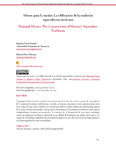
Please use this identifier to cite or link to this item:
http://ricaxcan.uaz.edu.mx/jspui/handle/20.500.11845/1070Full metadata record
| DC Field | Value | Language |
|---|---|---|
| dc.contributor | 19254 | es_ES |
| dc.contributor.advisor | https://orcid.org/0000-0003-3602-9115 | - |
| dc.contributor.other | 0000-0003-3602-9115 | - |
| dc.coverage.spatial | México | es_ES |
| dc.creator | Terán Fuentes, Mariana | - |
| dc.date.accessioned | 2019-09-04T17:44:27Z | - |
| dc.date.available | 2019-09-04T17:44:27Z | - |
| dc.date.issued | 2019 | - |
| dc.identifier | info:eu-repo/semantics/publishedVersion | es_ES |
| dc.identifier.issn | 2448-7554 | es_ES |
| dc.identifier.uri | http://ricaxcan.uaz.edu.mx/jspui/handle/20.500.11845/1070 | - |
| dc.identifier.uri | https://doi.org/10.48779/hpq4-bs43 | - |
| dc.description | In this research project, we set out to analyze the construction of the idea of a nation based on the political use of historical memory that was nurtured from 1821 to 1829 through rituals, readings and civic discourses. That period was characterized, among many other elements, by a growing interest in defining who should be considered the nation’s founding fathers and national heroes, complemented by celebrations held to commemorate Mexico’s birth as an independent country. Particularly interesting in this context was the construction of a new mythology based on a series of symbols that were chosen because of their foundational characteristics; especially the founding fathers and the Virgin of Guadalupe, symbols that served to promote the idea of a long-established nation with a nationalist historiography. | es_ES |
| dc.description.abstract | El propósito del artículo es analizar la construcción de la idea de nación a partir del uso político de la memoria histórica cultivada por rituales, sermones, oraciones cívicas pronunciados entre 1821 y 1829. En esos años se observa un interés por definir quiénes deben ser considerados padres de la patria, héroes nacionales y fiestas para conmemorar el nacimiento de México como nación independiente. Interesa, en particular, la cuestión de la formación de una nueva mitología basada en símbolos que fueron utilizados en su calidad de fundantes: los padres de la patria y la virgen de Guadalupe, símbolos que permitieron potenciar una idea de nación de largo aliento y una historiografía de corte nacionalista. | es_ES |
| dc.language.iso | spa | es_ES |
| dc.publisher | El Colegio de Michoacán | es_ES |
| dc.relation.uri | generalPublic | es_ES |
| dc.rights | Atribución-NoComercial-CompartirIgual 3.0 Estados Unidos de América | * |
| dc.rights.uri | http://creativecommons.org/licenses/by-nc-sa/3.0/us/ | * |
| dc.source | Revista Relaciones Estudios de Historia y Sociedad, Vol. 40, No 157, 2019, pp. 215-248 | es_ES |
| dc.subject.classification | HUMANIDADES Y CIENCIAS DE LA CONDUCTA [4] | es_ES |
| dc.subject.other | Nación | es_ES |
| dc.subject.other | memoria | es_ES |
| dc.subject.other | retórica | es_ES |
| dc.subject.other | identidad | es_ES |
| dc.subject.other | homogeneidad | es_ES |
| dc.title | Héroes para la nación. La edificación de la tradición septembrina mexicana | es_ES |
| dc.title.alternative | National Heroes. The Construction of Mexico’s September Traditions | es_ES |
| dc.type | info:eu-repo/semantics/article | es_ES |
| Appears in Collections: | *Documentos Académicos*-- UA Historia | |
Files in This Item:
| File | Description | Size | Format | |
|---|---|---|---|---|
| Heroes para la nacion.pdf | 272,02 kB | Adobe PDF |  View/Open |
This item is licensed under a Creative Commons License
